#Small Text Generator Tool
Explore tagged Tumblr posts
Text
Small Text Generator Tool - Bulk SEO Solutions

The Small Text Generator Tool is an efficient resource for users looking to create text in a compact format. This application uses advanced algorithms to transform standard text into smaller versions suitable for various purposes, including online communication and creative projects. Its user-friendly interface makes it accessible to individuals of all proficiency levels, while the tool’s versatility meets diverse needs, from social media posts to concise summaries. Overall, the Small Text Generator Tool is a practical solution for anyone needing brevity without sacrificing meaning.
#Small Text Generator#Small Text Generator Tool#bulk seo tools#digital marketing#free seo tools#online marketing#seo tools#small seo tools#free small seo tools#bulk seo solutions#bulkseosolutions
0 notes
Text
Using Small Word Generators for Better Content Structuring

In summary, writing in a clear and precise manner is one of the major challenges writers, marketers, and business owners face in their professions. The ability of content to flow easily enables the reader to engage better with it and also lends an advantage to its search ranking contention. But what if there were some elementary tools to help you structure your content better? This is where small word generators fit into the picture.
These words help by letting the user know about subtle places to change words with alternatives, encourage sentence shortening, and help reduce the bulk of text. Whereas blog posts, social media captions, and SEO articles attract a lot of traffic, small word generators help shine better content by clearing concepts for small word-gathered phrases. Let's dive into how these can help structure better content.
1. Unpacking Complex Ideas
Sometimes, we make our writing complicated by using long, cumbersome sentences that are stuck with jargon. What a small word generator would do for such content is to counterbalance the jargon by suggesting simple alternatives that are short and crisp. To use an example, instead of "Utilizing an advanced strategy for optimization," one may always say, "Using a smart plan for better results."
Simplify your content and your audience will be more engaged and relaxed.
2. Making Readable Content Search-Engine-Friendly
Search engines give good rankings to readable content. They really love Hemingway Editor or Grammarly, and even small-word suggestions take them a long way in helping readability. Long words replaced by their short equivalents mean fluidity within your content, which also contributes to better SEO rankings and engaged users.
A neat little trick? Wherever possible, use small words. That way your reader doesn't have to stop and decipher your meaning.
3. Changing the flow and coherence of the content
An article, if well-designed indeed, naturally proceeds. Small word generators help link sentences into a smooth flow through better transitional word choices, for instance:
Before: "We must understand the significance of SEO. Moreover, keyword placement matters."
After: "Understanding SEO is essential. Also, keyword placement matters."
In this way, refinement smoothingly enhances the connection between thoughts, making them beautiful to read.
4. Optimizing Headlines and Sub-Headlines
Headlines and sub-headlines should attract. A small word generator can optimize greater titles whose catchy and impactful nature improves click-through rates (CTR).
To write this:
🚫 "Utilizing Advanced Strategies for Content Optimization"
✅ "Smart Ways to Optimize Your Content"
Shorter, clearer headings will maintain reader engagement and improve the skim-readability of the article.
5. Crafting Engaging CTA
A great CTA boosts conversions for any piece of marketing whether it’s a blog, email, or landing page. Small word generators suggest persuasive and action-oriented words so your CTA is stronger.
Before: "Click here to learn more about SEO."
After: "Discover SEO tips today!"
Minor alterations using a small word generator can significantly impact engagement.
6. A Refined Social Media Caption
In environments like Twitter, Instagram, or LinkedIn, every word counts. The use of a small-word generator can help you shorten an already impactful message.
For example, instead of:
🚫 "An in-depth guide on how to improve content strategy and maximize engagement."
✅ "Boost your content strategy with these simple tips!"
Short captions grab attention and facilitate engagement.
7. Increasing Email Open Rates
The only judge of an email is the subject line. Small word generators create attention-grabbing subject lines that boost open rates.
Before: "Check out this exclusive deal that will save you money on our products!"
After: "Save big with this exclusive deal!"
Easy is best when it comes to email marketing.
8. Improving Writing Skills for Non-Native English Writers
Small word generators serve as an invaluable way to simplify writing for anyone undertaking a second tongue in English. By changing bond-appointed substitute words, they ensure that the will-not-go-down message is put across to the reader.
Instead of: 🚫"This initiative will be advantageous for all parties concerned."
✅ "This plan benefits everyone."
Simple changes make communication and audience connectivity greater.
Final Thoughts
It’s easy to see how small word generators are the little things that matter for content structure. These tools are relevant to your content whether you want to simplify ideas or do lots of SEO, readability, or social media captions.
So if you're having trouble with smooth content flow or engagement, let a small word generator come to your sometimes manageable distinctions that can bring forth big change!
1 note
·
View note
Text
PALESTINE FILM INDEX
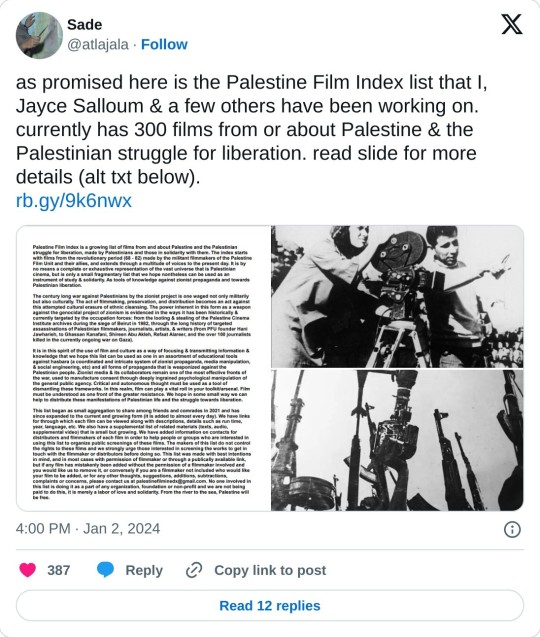
Palestine Film Index is a growing list of films from and about Palestine and the Palestinian struggle for liberation, made by Palestinians and those in solidarity with them. The index starts with films from the revolutionary period (68 - 82) made by the militant filmmakers of the Palestine Film Unit and their allies, and extends through a multitude of voices to the present day. It is by no means a complete or exhaustive representation of the vast universe that is Palestinian cinema, but is only a small fragmentary list that we hope nontheless can be used as an instrument of study & solidarity. As tools of knowledge against zionist propaganda and towards Palestinian liberation.
The century long war against Palestinians by the zionist project is one waged not only militarily but also culturally. The act of filmmaking, preservation, and distribution becomes an act against this attempted cultural erasure of ethnic cleansing. The power inherent in this form as a weapon against the genocidal project of zionism is evidenced in the ways it has been historically & currently targeted by the occupation forces: from the looting & stealing of the Palestine Cinema Institute archives during the siege of Beirut in 1982, through the long history of targeted assassinations of Palestinian filmmakers, journalists, artists, & writers (from PFU founder Hani Jawharieh, to Ghassan Kanafani, Shireen Abu Akleh, Refaat Alareer, and the over 100 journalists killed in the currently ongoing war on Gaza).
It is in this spirit of the use of film and culture as a way of focusing & transmitting information & knowledge that we hope this list can be used as one in an assortment of educational tools against hasbara (a coordinated and intricate system of zionist propaganda, media manipulation, & social engineering, etc) and all forms of propaganda that is weaponized against the Palestinian people. Zionist media & its collaborators remain one of the most effective fronts of the war, used to manufacture consent through deeply ingrained psychological manipulation of the general public agency. Critical and autonomous thought must be used as a tool of dismantling these frameworks. In this realm, film can play a vital roll in your toolkit/arsenal. Film must be understood as one front of the greater resistance. We hope in some small way we can help to distribute these manifestations of Palestinian life and the struggle towards liberation.
This list began as small aggregation to share among friends and comrades in 2021 and has since expanded to the current and growing form (it is added to almost every day). We have links for through which each film can be viewed along with descriptions, details such as run time, year, language, etc. We also have a supplemental list of related materials (texts, audio, supplemental video) that is small but growing. We have added information on contacts for distributors and filmmakers of each film in order to help people or groups who are interested in using this list to organize public screenings of these films. The makers of this list do not control the rights to these films and we strongly urge those interested in screening the works to get in touch with the filmmaker or distributors before doing so. This list was made with best intentions in mind, and in most cases with permission of filmmaker or through a publically available link, but if any film has mistakenly been added without the permission of a filmmaker involved and you would like us to remove it, or conversely if you are a filmmaker not included who would like your film to be added, or for any other thoughts, suggestions, additions, subtractions, complaints or concerns, please contact us at [email protected]. No one involved in this list is doing it as a part of any organization, foundation or non-profit and we are not being paid to do this, it is merely a labor of love and solidarity. From the river to the sea, Palestine
#this is incredible#palestinian cinema#palestine film index#link on title!!#world cinema#film#dailyworldcinema#albertserra
2K notes
·
View notes
Text
Often when I post an AI-neutral or AI-positive take on an anti-AI post I get blocked, so I wanted to make my own post to share my thoughts on "Nightshade", the new adversarial data poisoning attack that the Glaze people have come out with.
I've read the paper and here are my takeaways:
Firstly, this is not necessarily or primarily a tool for artists to "coat" their images like Glaze; in fact, Nightshade works best when applied to sort of carefully selected "archetypal" images, ideally ones that were already generated using generative AI using a prompt for the generic concept to be attacked (which is what the authors did in their paper). Also, the image has to be explicitly paired with a specific text caption optimized to have the most impact, which would make it pretty annoying for individual artists to deploy.
While the intent of Nightshade is to have maximum impact with minimal data poisoning, in order to attack a large model there would have to be many thousands of samples in the training data. Obviously if you have a webpage that you created specifically to host a massive gallery poisoned images, that can be fairly easily blacklisted, so you'd have to have a lot of patience and resources in order to hide these enough so they proliferate into the training datasets of major models.
The main use case for this as suggested by the authors is to protect specific copyrights. The example they use is that of Disney specifically releasing a lot of poisoned images of Mickey Mouse to prevent people generating art of him. As a large company like Disney would be more likely to have the resources to seed Nightshade images at scale, this sounds like the most plausible large scale use case for me, even if web artists could crowdsource some sort of similar generic campaign.
Either way, the optimal use case of "large organization repeatedly using generative AI models to create images, then running through another resource heavy AI model to corrupt them, then hiding them on the open web, to protect specific concepts and copyrights" doesn't sound like the big win for freedom of expression that people are going to pretend it is. This is the case for a lot of discussion around AI and I wish people would stop flagwaving for corporate copyright protections, but whatever.
The panic about AI resource use in terms of power/water is mostly bunk (AI training is done once per large model, and in terms of industrial production processes, using a single airliner flight's worth of carbon output for an industrial model that can then be used indefinitely to do useful work seems like a small fry in comparison to all the other nonsense that humanity wastes power on). However, given that deploying this at scale would be a huge compute sink, it's ironic to see anti-AI activists for that is a talking point hyping this up so much.
In terms of actual attack effectiveness; like Glaze, this once again relies on analysis of the feature space of current public models such as Stable Diffusion. This means that effectiveness is reduced on other models with differing architectures and training sets. However, also like Glaze, it looks like the overall "world feature space" that generative models fit to is generalisable enough that this attack will work across models.
That means that if this does get deployed at scale, it could definitely fuck with a lot of current systems. That said, once again, it'd likely have a bigger effect on indie and open source generation projects than the massive corporate monoliths who are probably working to secure proprietary data sets, like I believe Adobe Firefly did. I don't like how these attacks concentrate the power up.
The generalisation of the attack doesn't mean that this can't be defended against, but it does mean that you'd likely need to invest in bespoke measures; e.g. specifically training a detector on a large dataset of Nightshade poison in order to filter them out, spending more time and labour curating your input dataset, or designing radically different architectures that don't produce a comparably similar virtual feature space. I.e. the effect of this being used at scale wouldn't eliminate "AI art", but it could potentially cause a headache for people all around and limit accessibility for hobbyists (although presumably curated datasets would trickle down eventually).
All in all a bit of a dick move that will make things harder for people in general, but I suppose that's the point, and what people who want to deploy this at scale are aiming for. I suppose with public data scraping that sort of thing is fair game I guess.
Additionally, since making my first reply I've had a look at their website:
Used responsibly, Nightshade can help deter model trainers who disregard copyrights, opt-out lists, and do-not-scrape/robots.txt directives. It does not rely on the kindness of model trainers, but instead associates a small incremental price on each piece of data scraped and trained without authorization. Nightshade's goal is not to break models, but to increase the cost of training on unlicensed data, such that licensing images from their creators becomes a viable alternative.
Once again we see that the intended impact of Nightshade is not to eliminate generative AI but to make it infeasible for models to be created and trained by without a corporate money-bag to pay licensing fees for guaranteed clean data. I generally feel that this focuses power upwards and is overall a bad move. If anything, this sort of model, where only large corporations can create and control AI tools, will do nothing to help counter the economic displacement without worker protection that is the real issue with AI systems deployment, but will exacerbate the problem of the benefits of those systems being more constrained to said large corporations.
Kinda sucks how that gets pushed through by lying to small artists about the importance of copyright law for their own small-scale works (ignoring the fact that processing derived metadata from web images is pretty damn clearly a fair use application).
1K notes
·
View notes
Note
Hi Mae!! I wanted to request a story where doctor!Remus and you are dating. You're out with James and Sirius whilst he's at work and you pass out/are sick/whatever you think fits the story and they freak out and take you to the hospital, where Remus sees you and loses his mind. He takes care of you and the guys are there for moral support. Also, reader is afraid of doctors in general but specially needles so putting that IV on is a hassle in itself hehe.
Thanks in advance!!!!
Hi, thanks for requesting!
cw: fear of hospitals and needles, somewhat angsty, mention of vomit (in the past tense, if that helps), this was sort of weird to write because I don't usually write reader arguing with their love interest like this but I hope it came out okay
doctor!Remus x fem!reader ♡ 1.3k words
You’re alerted to Remus’ arrival by Sirius’ shrill voice.
“Finally! I’ve been texting you.”
“We’re not really encouraged to be checking our phones during busy shifts,” says Remus. He sounds sharp and tired, and you look up from where your head rests on James’ shoulder just as he comes to a stop in front of your chair. A creased brow and gentle hands feeling at your forehead. “Hi, darling. Seems like that flu’s gotten a bit worse, hm?”
“You told us to check in on her,” Sirius goes on, “and we did, and we found her basically in a puddle of her own sick.”
“She’d been sick in the toilet, and then fell asleep on the bathmat,” James clarifies. “But she seemed really very ill.”
“Let’s go back,” Remus slides an arm around your waist, hoisting you up against his side and helping you walk towards the double doors that lead out of the waiting area. “What was her temp at when you found her?”
“We don’t know.” Sirius trails behind, exasperated. “We couldn’t figure out where you kept your thermometer, and she was hardly in a state to say.”
Remus makes a worried humming sound. “How are you feeling, dovey?”
“Tired,” you sigh, hoping you’re not leaning too hard against him but having a difficult time recalling what walking normally feels like, “‘nd my head hurts.”
“She seems a bit better than when we first found her,” James says. You think you detect some worry in his tone as well. “She was just waking up then, and Sirius got her to drink some water in the car.”
“Doesn’t sound like you’ve been taking very good care of yourself,” Remus murmurs, just for you. He kisses your head. “Poor love, I knew I shouldn’t have come to work today.”
“M’alright,” you say, letting him help you onto a small cot in a curtained-off room. Sirius and James file in behind you, and Remus shuts the curtain once they’re inside.
You look at him, and your surroundings, the machines and tools and the overwhelming harshness of it all, start to sink in for you.
“Can you take me home?”
Remus’ expression is gentle. “Not yet, sweetheart. You should be feeling much better once I do, though, yeah?” He brushes a piece of hair away from your face, encouraging you to lie back on the pillow. “Would one of you want to hop up here with her?” he asks the other boys, then to you: “You don’t mind sharing your bed, do you?”
“No,” you say, somewhat bemusedly. Sirius grins at you, climbing over you to lie down by your side.
“Thanks. I’m just gonna get your vitals now, dove.”
You feel a bit silly, but your nerves worsen as Remus checks you over, sticking plasticy things in your ear and cold metal on your back and making his various concerned faces. He must notice something when he takes your pulse, because he thumbs over the skin of your forearm comfortingly. Sirius, noticing, works an arm under your shoulders and pulls you close to his side.
“Alright,” Remus says in what you recognize to be his most soothing voice, “look at Sirius for me, please.”
You, of course, look in the opposite direction of where he wants you, and he’s taking your arm, pushing up your sleeve.
“Remus.” Betrayal sounds in your voice as you pull away from him, holding your arm close to your side.
He sighs. “You need fluids and medicine to get better. You want to go home, yeah?”
“I don’t want an IV,” you say in a tight voice.
Remus softens. He rubs your leg through your pajama pants. “I know, babydove, but you need to have one. I’ll get it over with as quickly as I can.”
“I had to have one last summer, when I got dehydrated,” James pipes up. He’s stolen a small stool likely meant for the doctor and is swiveling back and forth restlessly. “It wasn’t as bad as you might think. I hardly remembered it was there most of the time.”
“I just don’t want to,” you say again, voice going quiet and frail. Your vision starts to blur.
“Take a deep breath,” Remus coaches in that lulling voice. It’s half working, a familiar sort of comfort wrapping like a blanket around your frazzled nerves. You feel torn between your trust in your boyfriend and your absolute terror of everything that happens in a hospital. “You’re alright, yeah? This is the last thing you have to do for me. After, you can rest or have a nap, and when you’re well enough you can go home, okay? I might even be able to go with you.”
You shake your head wordlessly, feeling ridiculous and childish but altogether petrified as you wipe tears from underneath your eyes.
“Oh, sweetheart.” His brows pinch, and he leans over, kissing your temple. “You’ll be okay, I promise. Look over at Sirius, yeah?”
You cry but don’t resist as Sirius uses the arm around your shoulders to turn your face away, feeling Remus take your arm in his grasp. His fingers press gently into the crook of your elbow.
“Hey, it’s okay,” Sirius says quietly. He touches his lips to your forehead. “You’ve got this, babe, it’ll be over before you know it.”
Remus is obviously doing his best to make good on this promise. He ties the tourniquet quickly, and something cold and wet swipes over your skin. The bite of the needle doesn’t come as a surprise, but you take in a tiny, petrified breath anyway. It rasps wetly in your throat.
“You’re alright,” Remus murmurs, undoing the tourniquet as he speaks. “You’re doing so well, almost done now.”
You’re not in pain, necessarily, but the sensation of a foreign object in your arm is distinctly unsettling, and Sirius makes a soft sound of distress when your weeping worsens. None of this is helping your headache, either. Your sinuses throb.
“There.” You hear tape ripping, and then Remus is pressing it carefully over the spot in your arm. “There, done.”
Sirius lets go of your face. The moment you turn around Remus’ is on you, brushing away your tears and kissing your hairline apologetically.
“That’s it, darling, you can relax now. You did so well. Do you feel alright?”
“He means are you cross with him,” James translates helpfully.
Remus gives his friend an exasperated look, but his smile is sheepish. “That too, I suppose.”
“Honestly?” Your voice is pitchy. It scratches against your flu-torn throat. “A little, but not really. I’ll get past it.”
Remus gives a little laugh. “Oh, my love.” He bends forward, wrapping you up in a hug. “Thank you. I can live with that.” He holds the back of your head, rubbing between your shoulder blades firmly. When he lets you go, it’s with a kiss to your brow. “Sirius, get out of her bed. She needs to rest.”
“Excuse me?” Sirius is affronted. “I think I’ve just proven I make an excellent pillow. And where am I supposed to sit? James has taken the only stool.”
“He can stay,” you tell Remus.
“Thank you, gorgeous. See? Jamie, come over here so we can watch a film on your phone.”
Remus rolls his eyes, stepping aside to let James scoot by on his stool. “Fine, but try to get some actual sleep. I want your temperature down when I come back to check on you, yeah?”
“You’re the doctor,” Sirius points out, getting cozy on his side of the bed as you and James scroll through films. “What’s she supposed to do, will it down? Sod off.”
Remus heaves a long-suffering sigh, pulling off his gloves and dropping them in the trash can. “So glad you’re here.”
“And where would your girl be if we weren’t, Rem?” asks James, looking up from his phone to raise his brows. “She’s lucky to have us.”
Remus rolls his eyes, leaving the room. ���Aren’t we all.”
#doctor!remus lupin#doctor!remus#doctor!remus x reader#remus lupin au#remus lupin#remus lupin x reader#remus lupin x fem!reader#remus lupin x y/n#remus lupin x you#remus lupin x self insert#remus lupin fanfiction#remus lupin fanfic#remus lupin fic#remus lupin hurt/comfort#remus lupin angst#remus lupin sickfic#remus lupin imagine#remus lupin scenario#remus lupin drabble#remus lupin blurb#remus lupin one shot#remus lupin oneshot#marauders#marauders fanfiction#marauders fandom#the marauders#hp marauders#marauders x reader#needle tw#tw hospital
1K notes
·
View notes
Note
heyy i adore your art! do you have any advce for a small artist trying to get out there?
I guess it depends what you mean by “get out there”!
I’d say number one is to ignore the numbers. Unless you’re intentionally trying to sell yourself to some app’s algorithm, obsessing over the numbers will not help you.
The thing is, it is ok to care about other feedback you get on your art. I often hear social media treated like a dichotomy, to either “ignore it completely and draw for yourself” or to “strive to be a famous viral artist”. And I’m saying it’s not that simple.
It all boils down to why you’re making art. For some people, art is a much more personal expression, and it’s not meant to be seen by others. It’s more about the process and the catharsis than the outcome. This kind of art doesn’t need to be shared with other people.
For others, it’s a living. These people don’t mind that their art becomes “marketable”, if it becomes generic with a mass-appeal. This kind of art isn’t here to send a message, it’s here to look pretty. And that’s ok.
For me, art is communication. I’m telling stories. This is why I’m most drawn to comics and animation. I don’t pay attention to numbers, but I pay a lot of attention to comments because they help me gauge how successful I was at communicating an idea, an action, a joke, etc. It’s still important you develop thick skin. You have to detach yourself emotionally from them, and use them as a tool to help you learn.
This is why clarity is one of my biggest priorities in art. Clarity has less to do with skill and more to with “can you understand what this is you’re looking at”. There are some artists out there who are very good at what they do, but they still struggle with clarity. And the inverse is true; even beginner artists can have clear, easy to follow art.
Some things I actively try to do in my art to improve clarity:
Is the pose clear? Is the figure overlapping themself too much, or is the action still readable from the silhouette?
If there’s text, is it clear? Is the direction of speech bubbles confusing? Is my handwriting/font easy to read?
Would a background or prop help clarify the setting better? (What’s the least amount of effort I can put into this that will give the necessary information?)
Are my lines too loose? Sometimes it’s fine, but if they’re too unconnected, the form gets lost. Should I close my lines better, or maybe add a tone to separate the positive and negative space?
Does the “punchline” make sense? What AM I saying? What could communicate it stronger?
If your art is clear, people will find it and share it! Just keep telling the stories you wanna tell, make the art YOU want to see, and your audience will build around you!
239 notes
·
View notes
Text
pac: what could you try in the occult arts?


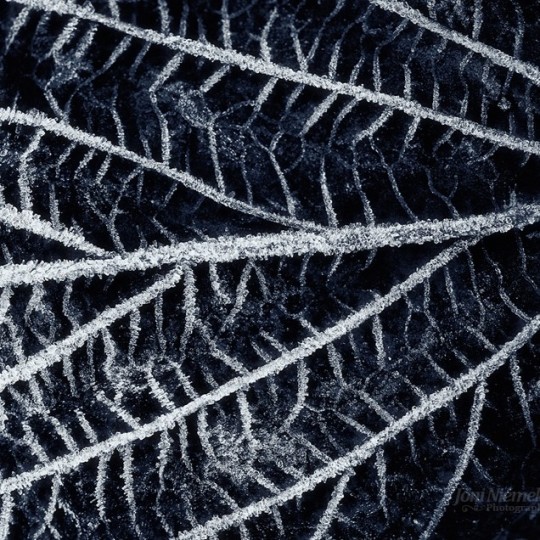
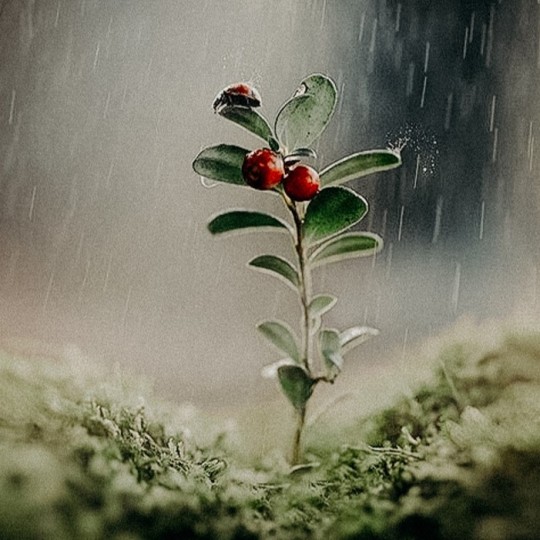


general reading. pick a pile, listening to your intuition. if nothing resonates, leave this pac behind.

pile 1
how about trying to make dreamcatchers for your loved ones? or wind chimes? these instruments are relatively simple, but when made with good intentions, with magical power embedded, they bring many positive changes to the lives of those to whom they are given, from clearing thoughts to changing the atmosphere in the room. you have the power to bring these changes to others, and the process of creating these amulets will help you better reveal your creative abilities and gain generosity of energy.
pile 2
i suspect you've never tried this, but you could try smoke or steam divination. this is a rare form of divination, similar to water or mirror divination - you look at the figures the smoke shows you, and they tell you a story about the past, present and future. try lighting your favorite candle and blowing it out, watching the smoke sway, prepare the smudging ritual and look into the clouds. or even add your favorite essential oil to hot water and watch the rising steam speak to you. just remember to protect your respiratory system and your eyes, be careful.
pile 3
manifestation. moreover, you can turn not only to well known written forms, but also try vocal manifestation. first, listen to your voice, to every word you say, and try to endow them not only with meaning, but also with power. each of your words is important and weighty, remember this, and be confident in yourself and your desires. if you do not like the sound of your speaking voice, try using other sounds or also singing. the human voice is very transformative, and this will give you many opportunities to embody your will in sound.
pile 4
try working with the moon and making moon water. the moon helps to develop intuition, look deep into yourself and explore what can never be described in words. and moon water can help you on the path to knowing others and yourself. for many, moon water is a tool for clearing the mind and energy - and you can try using it by adding it to your bath to charge yourself with the energy of the moon, revealing your potential more fully.
pile 5
have you ever tried to create talismans? these are small special objects that can look completely different. they often help to overcome adversity, they protect, provide support. talismans are created with pure intentions and are given to those for whom they are intended - these are deeply individual objects that you yourself cover with the necessary symbols, use the necessary materials and choose the colors and textures.
pile 6
try cleansing rituals with earth or salt. you may have tried this before, but there is always a new twist on old. you can write down everything you want to get rid of and bury this text at a crossroads. you can create a witch's bottle for cleansing, using salt, stones and even bones that suit your intentions. and if you don't have access to such objects but want to cleanse your own body, soul and mind, get out into nature, touch the Earth with your hands and ask it to ease your burdens.

thanks for the reading!
dividers by @strangergraphics-archive, all images are not mine
224 notes
·
View notes
Text
when I was in middle school (around 2010 or so), we read a short story about a machine that took in the writings of thousands, millions of books, and, after analyzing them all to learn how to write by example, generated new books in a short amount of time, and we had to discuss it as a class.
I was beginning to get into programming, and one of the things I'd learned about was markov chains, which put simply, allowed primitive chat bots to form sentences by analyzing how the words we used in conversations were ordered and strung together words and phrases that had a high probability of appearing next to each other. with the small dataset that was our chatroom, this often led to it regurgitating large chunks of sentences that appeared in our conversations and mashing them together, which was sometimes amusing. but generally, the more data it collected, the more its ability to output its own sentences improved. essentially, it worked a lot like the predictive text on your phone, but it chose the sequence of words on its own.
and yet, in that class discussion, everyone decried the machine in that story for committing plagiarism. they didn't seem to understand that the machine wasn't copying from the books it was fed verbatim, but using the text of those books to learn how to write its own books. I was bewildered by everyone's reactions, because I had already seen such a machine, or at least a simple approximation of one. if that chat bot had taken in the input of millions of books' worth of text, and if it used an algorithm that wasn't so simplistic, it likely would have been even better at coming up with responses.
there is valid criticism to be made about ai, for sure. as it stands, it is a way for the bourgeoisie to reduce labor costs by laying off their employees, and in an economic system where your ability to survive is tied to employment, this is very dangerous. but the problem there, of course, is the economic system, and not the tool itself. people also often disparage the quality of ai-generated art, and while I generally agree that it's usually not very interesting, that's because of the data it's been trained on. ai works best when it has a lot of data to work with, which is why it's so good at generating art with styles and motifs that are already popular. that is to say, people were already writing and drawing bland art that's made to appeal to as wide of an audience as possible, because that's the kind of art that is most likely to turn a profit under capitalism; it was inevitable that ai would be used to create more of it more efficiently when it has so many examples to learn from. but it's bizarre to see that the way people today react to generative ai is exactly the same as the way my classmates in middle school reacted.
170 notes
·
View notes
Note
As you've asked for asks!:
Do you have any quick-and-dirty book/fic binding methods a terrified-of-failure novice could use to bang something out to get over the first collywobbling step of Actually Doing The Thing? (this may be something I've been meaning to ask for ages)
yes! I absolutely do! in my opinion the best quick-and-dirty bookbinding method is a no-glue pamphlet: you don't have to mess with glue or measuring or cutting anything, all you need is your text, some paper, a needle and thread. you can use the same needle to punch holes if you don't have an awl.
this is going to be a little long but that's because I'm going to write out some fairly detailed instructions for an A5 sized pamphlet. If you don't want detailed instructions and think you can glean the necessary info from photos, just skip to the photos! I've also linked tutorials.
for preparing the text to printing, in whatever software you use (word, libreoffice, gdocs, whatever) make sure your document is set to page size A5. make it look readable. then save as/export that document as a straight-paged PDF. now go to the bookbinder JS tool (https://momijizukamori.github.io/bookbinder-js/), and upload the PDF. source manipulation: none printer paper size: A4 display unit (you can ignore, or choose cm if it gives you anxiety that it automatically displays points) printer type: select single-sided or duplex accordingly* rotate paper: ignore flip on long side: check if you are printing duplex and if your duplex printer flips the paper on the long side page layout: tick folio page scaling: original page positioning: centered ignore the rest flyfleaf: ignore signature format tick: standard signatures. in the length drop down, this depends on the type of pamphlet you are doing. for folio i generally find 4-5 pages per signature a comfortable thickness. if you have 6 whole A4 pages you can still do that as a single signature or you can split it into two signatures 3 pages each. wacky small layouts: ignore this signature info click the generate preview button to see what your PDF looks like imposed! I love this step especially when I'm doing quarto (A6) or octavo (A7) sized books generate output - click this to generate an imposed PDF
for A6 and A7 sized books the instructions are much the same, except for these you make sure the page size is A6 or A7 in your software, and then you choose quarto or octavo instead of folio. for signature length drop down I keep signature length to 1 for octavos typically and 2 for quartos, as this still refers to sheets of paper, and for octavo 1 sheet of A4 paper will turn into 4 smaller sheets in one signature once folded and cut.
*if you don't have a duplex printer you will have to manually turn the paper to print on the other side. I cannot be arsed with this so I bought a printer capable of duplex printing (I didn't have a printer anyway). if you already have a printer check what it can do as you might be surprised and go from there.
now to the pamphlets! you don't need a cover - I have one for the long stitch pamphlet but for the saddle stitch one I didn't bother and just made sure the first page had a title on it. you can always take a different piece of paper and print a cover on or or just use coloured cardstock and create a simple cover, but a cover is not necessary unless you're doing a long stitch pamphlet. all you need to do is to punch holes and start sewing. there are a few different stitch types below, I wouldn't say any of them are more difficult or easier than others, but they do look different so...pick one you like the look of and go from there?
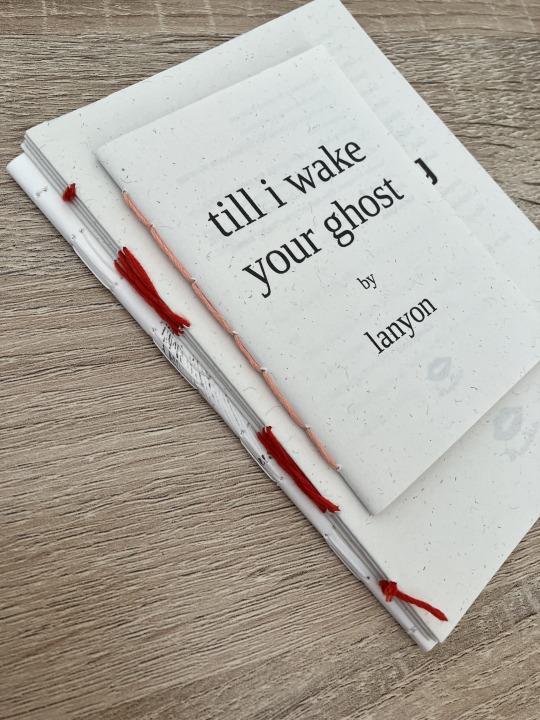
pamphlet stitch (uneven number of holes) I haven't ever done a pamphlet stitch but here's a tutorial for how to do it: https://www.starpointestudio.com/simple-pamphlet-stitch-book-step-by-step/
saddle stitch (uneven number of holes) I realised that what I was thinking of as a pamphlet stitch is actually saddle stitch, as in this A7 pamphlet:
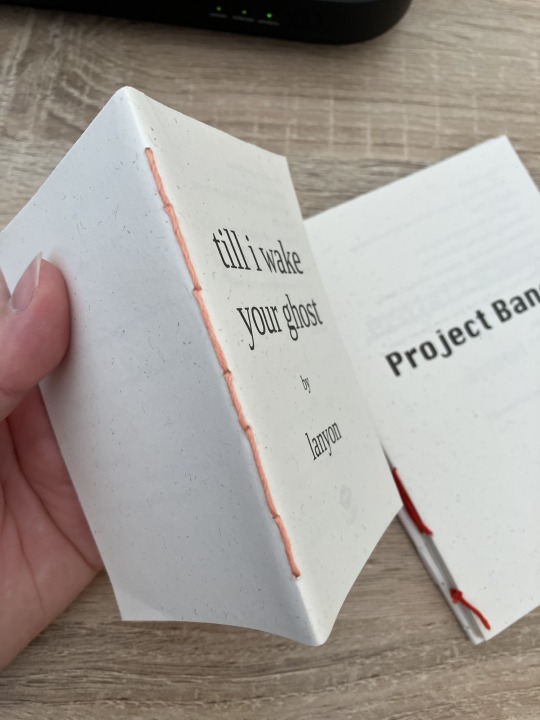
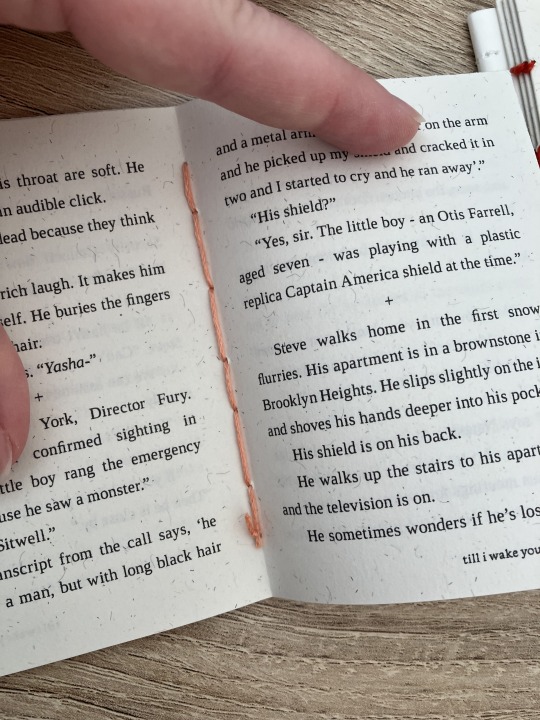
here's a tutorial for how to sew saddle stitch: https://www.bookbindingworkshopsg.com/saddle-stitch-bookbinding-tutorial/ here's a video tutorial: https://www.youtube.com/watch?v=aWHkY5jOoqM (sealemon has a lot of bookbinding tutorials and I know many people who like her videos, I used her tutorial for coptic binding way back when I first made a book but I can't otherwise vouch for the quality as I haven't used her videos)
french link stitch (even number of holes) in this one I used french link stitch which I typically use for thicker textblocks that i'm not planning to use tapes with as the french link gives it some robustness, I used it here because I had never done it before and wanted to try it out. I am planning to take these stitches out and re-sew this pamphlet with a cover now that I've found a suitable piece of transformer fanart to use as a cover:
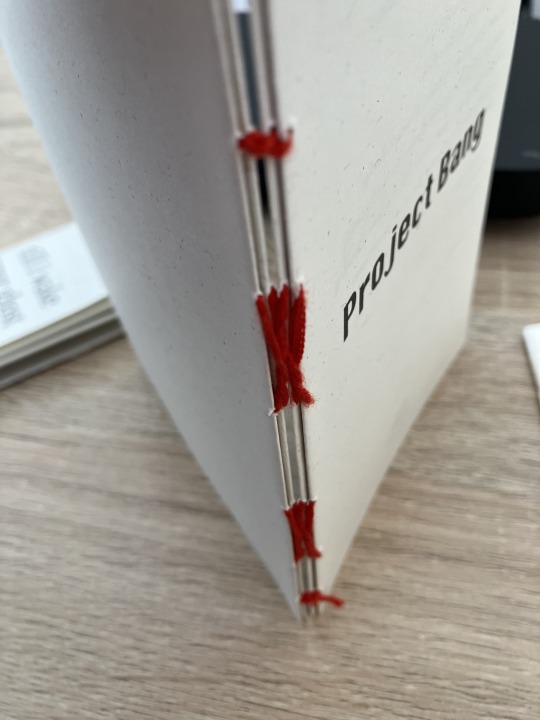
french link tutorial. it's quite long but it has a colour coded bit towards the end that shows how the thread is supposed to link which i find very helpful to visualise: https://www.handmadebooksandjournals.com/bindings/french-link-stitch-binding/
here's a video tutoral from DAS bookbinding (he is my go to for techniques and he has the most soothing Australian accent as well, though fair warning not all of his videos are for beginners): https://www.youtube.com/watch?v=O4ZPdbaM-Ws
long stitch (even number of holes) for this one I used long stitch and I had a cover. this one is my favourite variation because I can make these pretty and simple covers and the stitch looks nice on the outside as well, so this one scratches the 'i want to make a book' itch for me.
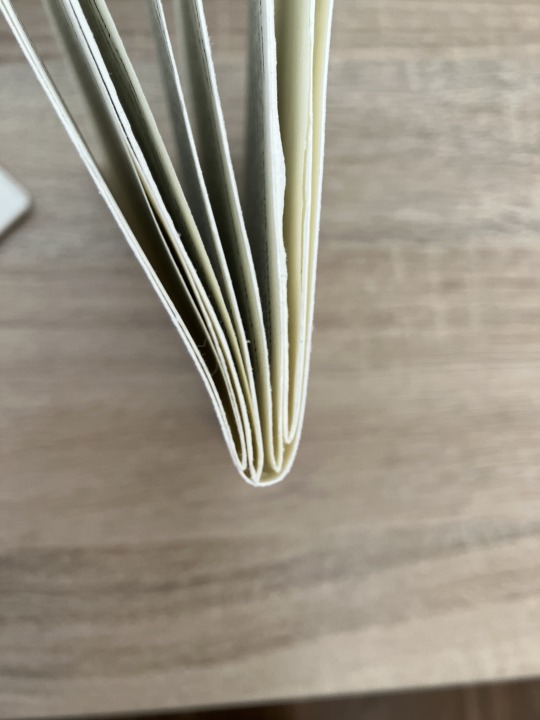
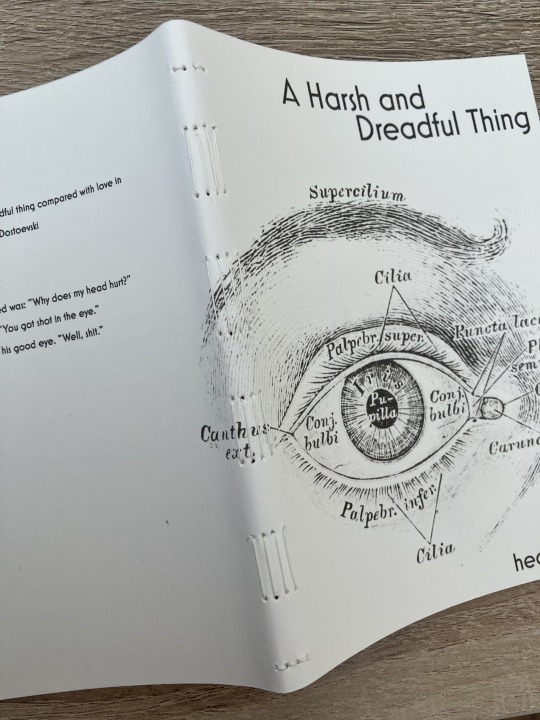
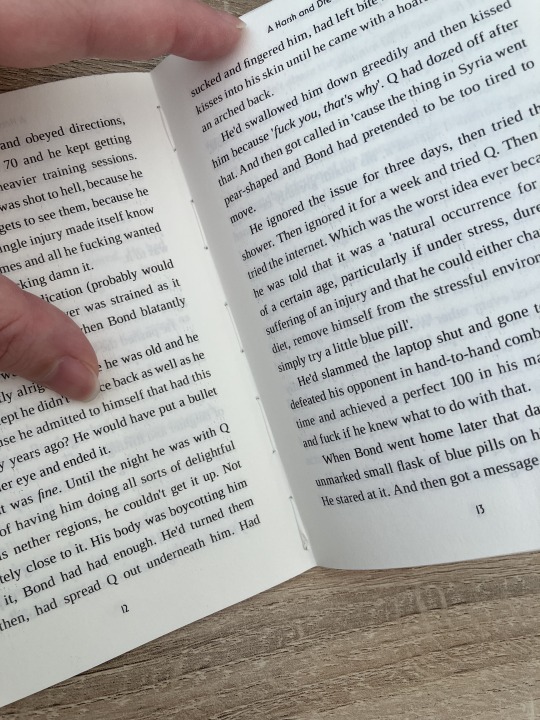
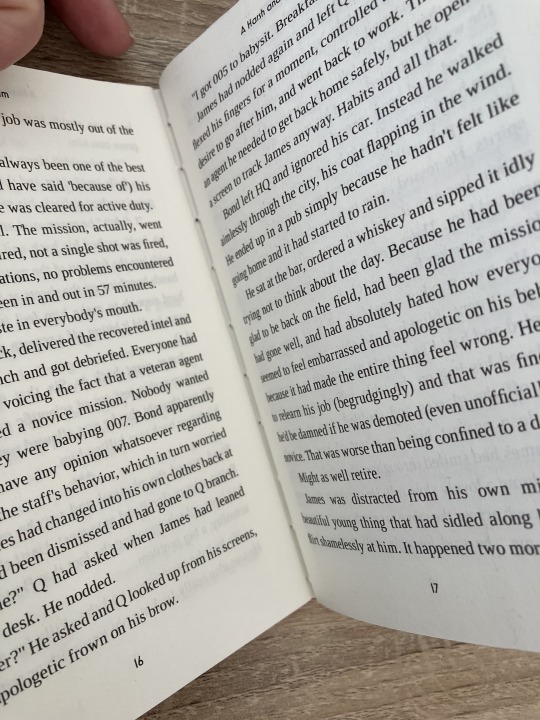
here's a tutorial that also includes a how to on a cover that is different from my cover: https://lccprintmaking.myblog.arts.ac.uk/files/2020/06/Long-Stitch-Tutorial-A4.pdf DAS also has a video tutorial for long stitch but it's like three videos long, maybe watch it later :'D here's one I haven't watched but seems decent: https://www.youtube.com/watch?v=XnignTL_wDQ
you can use saddle stitch for this kind of pamphlet as well, that's what I did for dozens of ships and hundreds of souls (https://ashmouthbooks.tumblr.com/post/681587080267202560).
I hope this helped!!
2K notes
·
View notes
Text
Something I noticed in my re-reads of the manga is that Light and Near’s inner monologues tend to pretty directly state what exactly they mean with minimal ambiguity. However with L and Mello their internal thoughts often taper off before reaching their conclusions, or are otherwise just positioned more mysteriously leaving their true feelings and intentions to the imagination of the reader.
For one example, something I always find interesting are Mello’s comments around Misa.
Let me explain. It's this panel I mean:
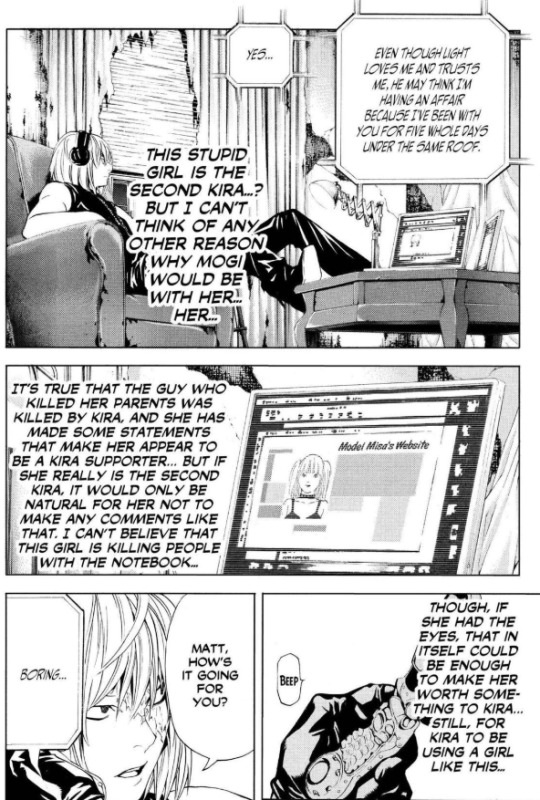
What I'm curious about is when he says: "if she had the eyes that in itself could be enough to make her worth something to Kira...still for Kira to be using a girl like this..."
While his statements read plainly enough the interpretation can go in a couple very different ways. And of course this being manga (oh and being CUT from the anime doesn't help) the absence of tone makes his intention all the more ambiguous.
I'm curious where is the emphasis on that statement? Is it:
"...still for Kira to be using A GIRL like this..." (implying some general objection to using a girl in the role of the second Kira)
OR
"...still for Kira to be using a girl LIKE THIS..." (implying a specific distaste for exploiting this woman's stupidity, the loss of her parents, and subsequent devotion to Kira and possible willingness to sacrifice half her remaining life for the eyes to help her heroic savior).
My own position is I tend to lean to the latter interpretation. I think he's bothered by the way Kira is weaponizing Misa's trauma and idolization of him. Yes I am biased, yet still believe there's more than enough textual basis to back up that reading.
Remember at this point Mello's been listening in on her and Mogi's conversations for almost a week (side note note that this shows Mello is fluent in Japanese since there's no reason Mogi and Misa would be speaking English when they're alone together). But it appears that nothing overtly suspicious is going on with them, and more than that their apparently inane and tedious conversations by this point are (understandably) grating on Mello's last nerve. He wonders how "This stupid girl is the second Kira? But I think of any other reason Mogi would be with her...her...". Yeah it's kinda mean to call her stupid, but the point is IF Kira was using her, it certainly wasn't for her brilliance. Also notice he repeats the word "her" twice, showing that he's thinking of her as in the individual sense not as a generic member of the female gender.
Also if his statement was just as a general sexist comment meant to say there's something fundamentally undesirable in entrusting a woman with that sort of power, there would have been no need for the panels showing him mulling over her personal history and possible motivations, making those connections in such detail. Plus unlike some other characters in the series, Mello isn't known make prejudicial comments about women.
Being a fellow orphan himself, and one whose trauma and devotion was ALSO exploited similarly -- raised to be a tool serving someone else's vision, and not only that but similarly having bought fully into it and making it his own life goal -- he might be able to relate to Misa's situation more than most.
It's also worth mentioning that I wouldn't necessarily consider it out of character for Mello to be rubbed the wrong way by how Kira is using Misa. Mello is shown multiple times throughout the manga to be openly empathetic (which goes hand in hand with his infamous trait of unapologetically having emotions), including to his enemies. See Soichiro Yagami, Kiyomi Takada.
Anyway, it's a small detail to devote this much thought and rambling text to, but I think it's interesting so...
/shrug/
#mello#mello death note#mihael keehl#death note meta#misa amane#13 days of mello posting#day 6#overanalyzing again help
76 notes
·
View notes
Note
what steps do you go through to draw in your current style? do you have any pointers about it? its absolutely one of my favorites
i'm not sure if i think of my process in steps. in my head, i'm just straightforwardly drawing the shapes the characters are made of at angles that look right and building on that... luckily, i stream when i draw every day, so i have a ton of videos of myself drawing. example:
youtube
i haven't bothered to upload a lot of the modern streams to youtube because my video editor can't handle editing 4-8 hour files even if i'm speeding them up and technically making them shorter because of the way video editors interact with files, and the freeware i use isn't able to make proxy files. the act of downloading and editing and combing through all the footage is a ton of time and memory space and it's just not what people are usually looking for from me, so it's not where i wanna put my time.
but that's neither here nor there. what i mean to say is these vods are really long. so you don't want to rawdog those. but you can just download a video speed controller extension to your browser and it's extremely easy to cruise through the backlog of vods at ~15x speed.
i've gone ahead and highlighted some of the recent videos to separate the chaff from the wheat. i tend to take long breaks to eat or walk my dog so there are big periods of Nothing Happening. i'll try to skim some more and do the same. unfortunately, i don't have any good videos of me coloring, since twitch deletes vods after like a month, and i've just been focusing on sketching.
but yeah, in general, it really depends on how good i'm feeling on a given day -- sometimes i will sketch multiple times for just one panel and sometimes i won't sketch at all. i use paint tool sai 2 and a pixel brush usually 2 pixels wide with no pen pressure. for comics, i have 1 layer for the panel borders, 1 layer for the sketch, 1 layer for the lines, 1 layer for the colors, 1 layer for the text, and 1 layer speech bubbles. sometimes there are special effects that overlap borders and need their own special layers. when i start sketching a new panel, i will usually put it on its own new layer, and sometimes for multiple characters i will put them on another new layer at a different opacity. this is mostly to move them around without constant cleanup. once i've gotten a sketch pretty finished, i merge all of the layers into the sketch layer. the line layer is usually just the sketch layer cleaned up and paint bucket tooled black. but basically, the vast majority of my time working on art is spent trying to fix small things like tangents, fitting speech bubbles into panels, thinking about how to lay out a page, checking continuity interaction with other pages, that kind of stuff. the complex technical parts of the process are to save time on those in ways i can without compromising quality. the other portion of working on the art is like "step 1: draw head circle (or jessie head diamond). step 2: draw the rest of the owl." i don't know if this was helpful at all y_y if you want more pointers i might be able to offer clarity on more specific questions!
126 notes
·
View notes
Text
Reverse Text Generator Online: Flip & Mirror Text Easily

A Reverse Text Generator is a specialized tool that inverts the order of characters in a given text, resulting in a backward sequence. This tool serves various purposes, such as assisting with coding exercises, improving cryptographic techniques, and supporting creative writing projects by enabling authors to experiment with text manipulation.
#Reverse Text Generator#Reverse Text Generator Tool#free seo tools#online marketing#digital marketing#seo tools#small seo tools#bulk seo tools#free small seo tools
0 notes
Text
My controversial opinions about the current trend of highly minimalist Shakespeare:
I like a minimalist approach to the Bard, but I think it has to be done within certain parameters.
Too many theatres seem to think that either everybody already knows the play and they don’t need to worry about the audience understanding everything OR they assume that nobody cares about Shakespeare and massively cut down everything except the celebrity leading actors’ lines. But if you play your cards right, audiences might actually enjoy other aspects of the play besides the stars!
1. A smaller cast is fine, great even. I’ve heard the estimate that Shakespeare’s plays might have been originally performed by about 15 people. A cast of 11-15 tends to work well in most spaces.
You can do an enjoyable Shakespeare play with 8-10 people (with significant cuts and doubling), but it doesn’t do anything to IMPROVE the theatergoing experience. And under 8 actors? It better be done for comedic effect or highly avant- garde, or it will be incomprehensible to most.
2. If you’re using a lot of doubling/tripling/quadrupling, you need to differentiate characters with costumes. Having everyone wear plain black minimalistic outfits or military uniforms only works if half the actors aren’t playing 5 different people.
As originally staged, Shakespeare’s plays didn’t have much in the way of sets, but costumes did a lot of storytelling. Even if yours are simple and modern, they should tell us something about the characters. The humble Friar Lawrence and the powerful Prince Escalus probably wouldn’t dress the same.
3. Similarly, if you’re doubling, tripling, etc. and significantly abridging the script, do not cut dialogue like “I have disguised myself as a monk!” or “They will never know that I’m secretly Bob!” Otherwise, they might think this is a whole new character they need to keep track of if clothes/accessories are the only signifier for that!
4. Also, try not to cut too many lines that establish a sense of place if you don’t have actual sets. Lines like, “Here we are in the forest” or “We’ve finally reached France!” are Shakespeare’s audience lifelines!
5. If you’re combining small roles to create composite characters, pay attention to those characters’ arcs. For instance, if combining all the minor lords in Macbeth into Ross and Lennox, maybe one starts more naive and the other more jaded, maybe one turns against MacB long before the other.
Don’t assign them lines that don’t make sense for their role, like if Lennox teleports between Scotland and England from scene to scene or if someone reacts with shock to news they already witnessed firsthand in an earlier scene. In general, treat your supporting characters like characters, not just vehicles to move the plot forward for the lead actor’s star turn, even if the lead is played by a celebrity!
6. Relying on voice and facial expressions only to tell the story, absent of sets, costumes, props, ensemble characters, or action scenes only works in a suitably intimate space. I don’t want to sit in the nosebleed seats in a 2,000 seat theatre and see a huge bare stage with only 9 people sitting or standing, emoting to only the first few rows.
Sitting through a play without following the story at all will make lots of people hate Shakespeare who may have otherwise fallen in love with his work after attending your play. “Stripping Shakespeare down to its bare essentials” can be raw and invigorating, just be careful not to remove binding ingredients or the whole recipe falls apart. The text can be tricky enough to comprehend, let alone with next to no visual signifiers to guide them. Work with the text, not against it! So many helpful tools are built into it!
57 notes
·
View notes
Text
Some thoughts on Cara
So some of you may have heard about Cara, the new platform that a lot of artists are trying out. It's been around for a while, but there's been a recent huge surge of new users, myself among them. Thought I'd type up a lil thing on my initial thoughts.
First, what is Cara?
From their About Cara page:
Cara is a social media and portfolio platform for artists. With the widespread use of generative AI, we decided to build a place that filters out generative AI images so that people who want to find authentic creatives and artwork can do so easily. Many platforms currently accept AI art when it’s not ethical, while others have promised “no AI forever” policies without consideration for the scenario where adoption of such technologies may happen at the workplace in the coming years. The future of creative industries requires nuanced understanding and support to help artists and companies connect and work together. We want to bridge the gap and build a platform that we would enjoy using as creatives ourselves. Our stance on AI: ・We do not agree with generative AI tools in their current unethical form, and we won’t host AI-generated portfolios unless the rampant ethical and data privacy issues around datasets are resolved via regulation. ・In the event that legislation is passed to clearly protect artists, we believe that AI-generated content should always be clearly labeled, because the public should always be able to search for human-made art and media easily.
Should note that Cara is independently funded, and is made by a core group of artists and engineers and is even collaborating with the Glaze project. It's very much a platform by artists, for artists!
Should also mention that in being a platform for artists, it's more a gallery first, with social media functionalities on the side. The info below will hopefully explain how that works.
Next, my actual initial thoughts using it, and things that set it apart from other platforms I've used:
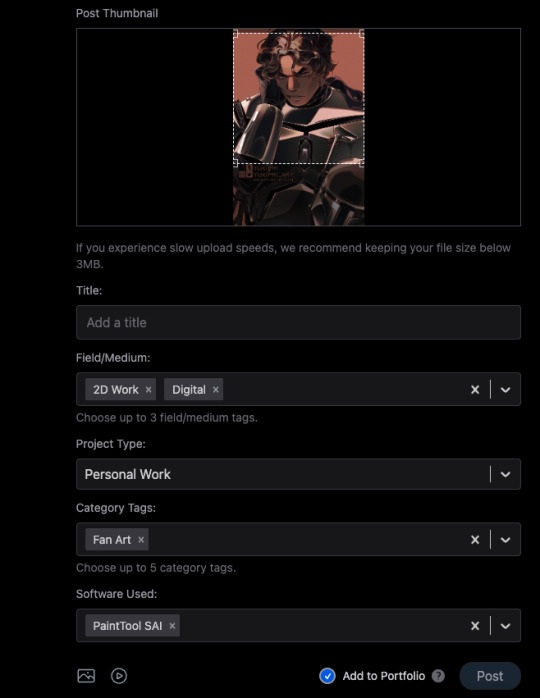
1) When you post, you can choose to check the portfolio option, or to NOT check it. This is fantastic because it means I can have just my art organized in my gallery, but I can still post random stuff like photos of my cats and it won't clutter things. You can also just ramble/text post and it won't affect the gallery view!
2) You can adjust your crop preview for your images. Such a simple thing, yet so darn nice.
3) When you check that "Add to portfolio," you get a bunch of additional optional fields: Title, Field/Medium, Project Type, Category Tags, and Software Used. It's nice that you can put all this info into organized fields that don't take up text space.
4) Speaking of text, 5000 character limit is niiiiice. If you want to talk, you can.
5) Two separate feeds, a "For You" algorithmic one, and "Following." The "Following" actually appears to be full chronological timeline of just folks you follow (like Tumblr). Amazing.
6) Now usually, "For You" being set to home/default kinda pisses me off because generally I like curating my own experience, but not here, for this handy reason: if you tap the gear symbol, you can ADJUST your algorithm feed!
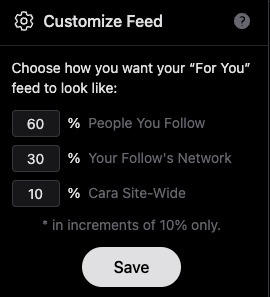
So you can choose what you see still!!! AMAZING. And, again, you still have your Following timeline too.
7) To repeat the stuff at the top of this post, its creation and intent as a place by artists, for artists. Hopefully you can also see from the points above that it's been designed with artists in mind.
8) No GenAI images!!!! There's a pop up that says it's not allowed, and apparently there's some sort of detector thing too. Not sure how reliable the latter is, but so far, it's just been a breath of fresh air, being able to scroll and see human art art and art!
To be clear, Cara's not perfect and is currently pretty laggy, and you can get errors while posting (so far, I've had more success on desktop than the mobile app), but that's understandable, given the small team. They'll need time to scale. For me though, it's a fair tradeoff for a platform that actually cares about artists.
Currently it also doesn't allow NSFW, not sure if that'll change given app store rules.
As mentioned above, they're independently funded, which means the team is currently paying for Cara itself. They have a kofi set up for folks who want to chip in, but it's optional. Here's the link to the tweet from one of the founders:
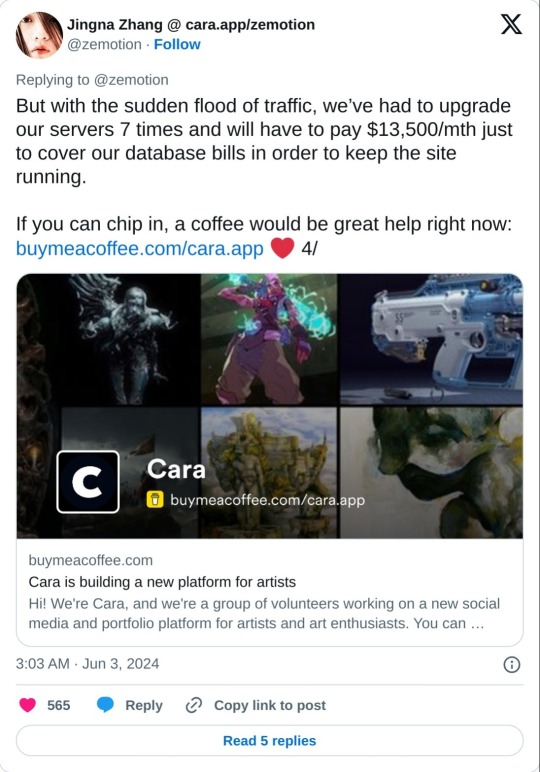
And a reminder that no matter that the platform itself isn't selling our data to GenAI, it can still be scraped by third parties. Protect your work with Glaze and Nightshade!
Anyway, I'm still figuring stuff out and have only been on Cara a few days, but I feel hopeful, and I think they're off to a good start.
I hope this post has been informative!
Lastly, here's my own Cara if you want to come say hi! Not sure at all if I'll be active on there, but if you're an artist like me who is keeping an eye out for hopefully nice communities, check it out!
#YukiPri rambles#cara#cara app#social media#artists on tumblr#review#longpost#long post#mostly i'd already typed this up on twitter so i figured why not share it here too#also since tumblr too is selling our data to GenAI
181 notes
·
View notes
Text
Pulp Covers And How To Paint Them
With the rise of cheap printing in the early twentieth century, mass-marked paperbacks swept the world, each offering lurid thrills for obscenely low prices. Sex, sadism, and incredible violence for as little as ten cents. An easy purchase to slot in between fifty cigarettes a day and enough bourbon slugs to kill a small garden.
Pulp fiction is where some of the greats of American literature cut their teeth, including the big three, Raymond Chandler, Ross MacDonald and Dashiell Hammett. The contents of these stories, both the dizzyingly good and astoundingly terrible, have been absorbed and digested and remixed and regurgitated in nearly every permutation imaginable, fuelling pop culture some one hundred years on. This isn't an essay on that. Nobody likes to open a tutorial and be greeted with a wall of text. The history is for another time.
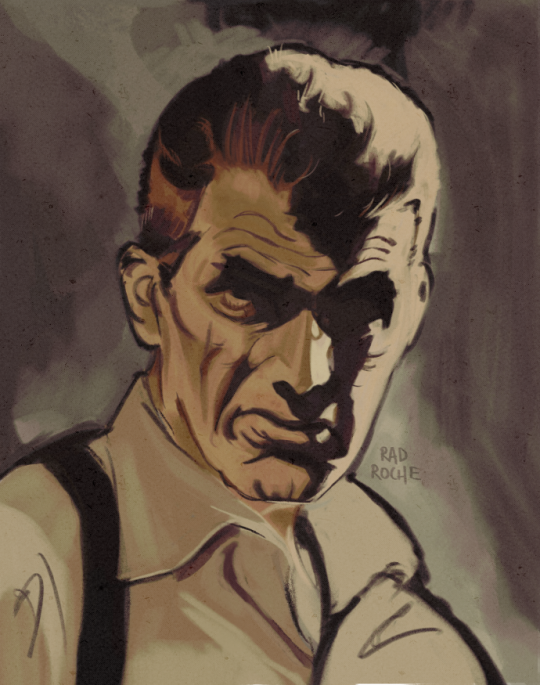
But it is about how to paint it.
Don't let the pre-amble intimidate you, it's not as hard as it sounds. You will need:
Painting software with some image editing capabilities. You don't need all the bells and whistles of Photoshop, but I wouldn't recommend something like MSPaint, at least not to start with. I'm using Clip Studio Paint.
A really beat-up paper texture. The grungier, the better.
A lightly-textured brush. Here are the specific brushes I use, 99% of which is the well-named rough brush. Try and avoid anything with any impasto elements.
Go to your colour-picking tool and use the 'select from layer' option. Doing all the painting on a single layer is going to make your life easier.
A complete willingness to make mistakes and, instead of erasing, painting over them. It generates much more colour variation and interest! Keep your finger off the E key.
Good reference! That painting is a master copy of Mitchel Hooks' art for Day of the Ram. Find a style you really love and want to learn? Have no clue where to begin? Do direct studies!
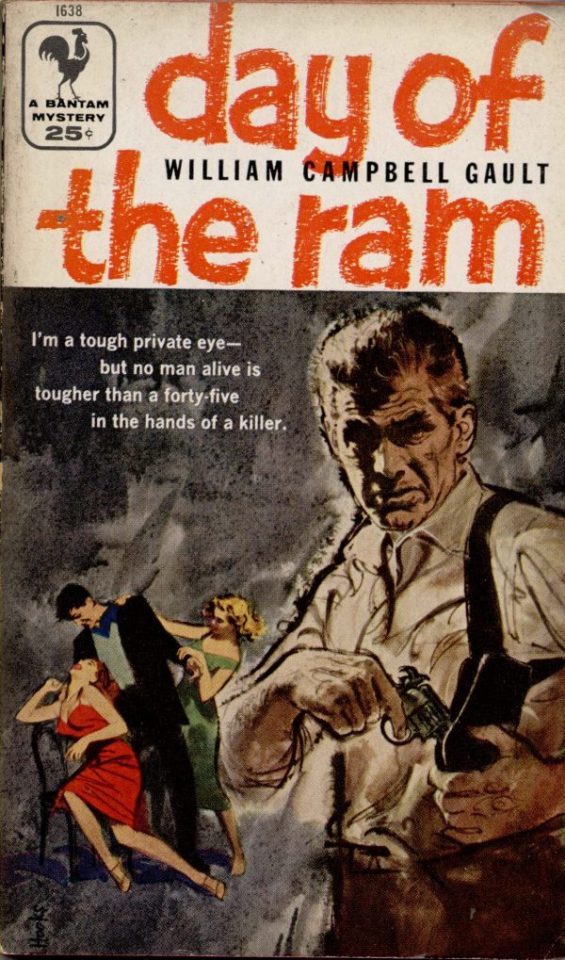
Let's not worry about whatever is happening in the background. It's probably fine. Let's get started! Pulp magazine art is a lot more varied than you might first think, so don't agonize over having a style that 'fits' or not. I'm also specifically aiming for something you'd see on the cover after printing, not the initial painting they would use for printing. The stuff I'll show here is a pretty narrow band of it, but here are some general commonalities. This is a painting by Tom Lovell.
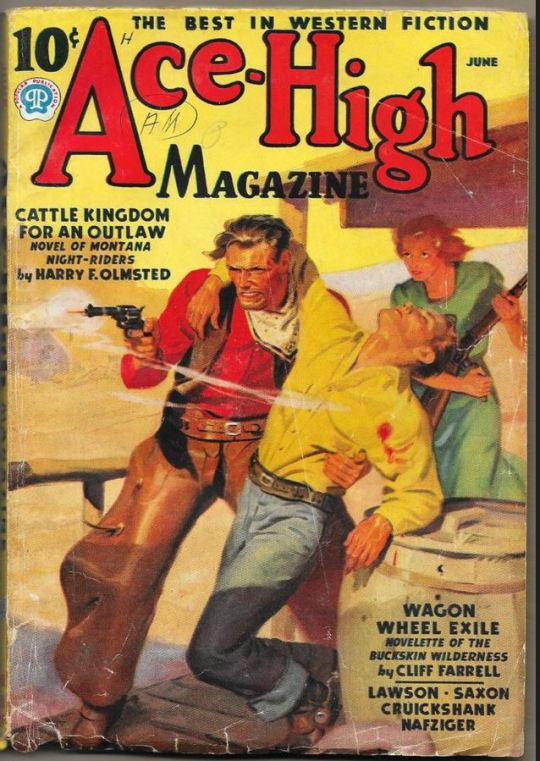
Let's dig into this.

The colours are very bright and saturated, but the actual values, the relative lightness and darkness of them, are actually grouped very simply! You can check this by filling a layer full of black, putting it on top and setting its mode to colour. If the value of a painting looks good, you actually get a lot of leeway with colour. But here's what I think is the most important thing to keep in mind.
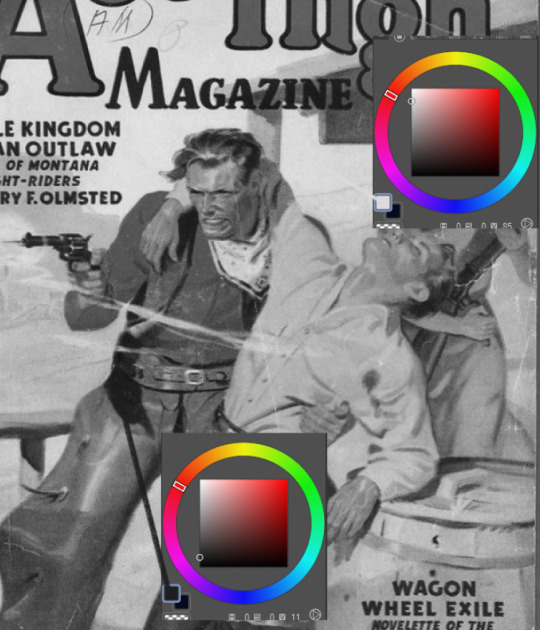
The darks aren't that dark, and the lights aren't all that light! Covers are paintings reproduced on cheap paper. Anything you wouldn't want to happen in the printing process, you lean into. Value wash-outs, lower contrast, colours getting a weird wash to them, really gritty texturing. So let's get painting! Here's my typical setup.
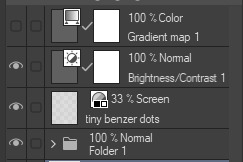
That bottom folder is the painting itself. The screen layer is the grungy paper texture. To get the effect you want, put it down, invert its colour, then set it to screen. That washes out your painting far, far too much, so to compensate, I put a contrast layer up on top. Fiddle around with the settings, but this is where mine ended up sitting.
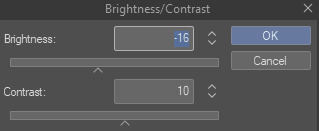
Note I'm saying this before even starting the painting: you want to do this as early as possible. This is where the 'select from layer' colour picker comes in handy. You can paint without worrying about the screen or contrast layer. Something not looking right? Enable your value check layer and keep painting. When you turn it off, it'll still be in colour. Here's a timelapse so you can see what that looks like.
And when you check the values...
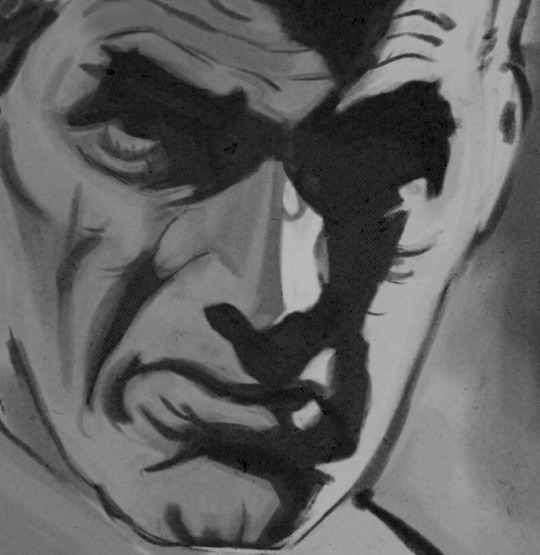
They're pretty simple! This isn't a be all and end all, but I hope it serves as a decent primer. I want thirty dames on my desk by Monday!
#rochedotpng#art tutorial#art resources#couldn't find a thing online about this style so here's how i do it#pulp#it's how i did the death shroud one more or less
357 notes
·
View notes
Note
How long does it take you to create a page and how do you usually go about creating an update? Where do you start?
It depends on the page. Some pages can take as many as 8 hours to complete while others maybe 5? It really has to do with the number of panels and the complexity (generally speaking it takes 1 hour per panel)
I always start by paneling out my page, so drawing all the boarders and designing the way the page flows. Then I add text and rough sketches. Typically “rough sketches” look something like this:

Just something to get down what I want and express the scene (also so I don’t get what I want). This step typically takes about an hour purely because I am indecisive and want everything a certain way.
After that I start going through and finalizing drawings and dialogue to be how I want. The last step is then adding sound effects and speech bubbles (though sometimes I will actually do the speech bubbles before drawing the pretty images depending on my day)
I use Clip Studio Paint which has tools like panel tools (literally like vector graphics that generate boxes that you can adjust and break) as well as bubble tools that help streamline a lot of this.
The page contents are decided by my script in a google doc I have that has every episode written out in advance (usually about 1 chapter ahead of what I’m working on). Occasionally I make edits because I catches inconsistencies in my writing or I get better ideas, but for the most part I follow it pretty closely. Granted it’s pretty vague, but in terms of following event orders and plot progression, it’s pretty close.
It looks something like this:

As you can see, there’s some differences in small details, but for the most part it’s almost the same. (I believe this draft hasn’t been updated to the version in which Shredder doesn’t arrive in New York until chapter 4)
Good question! :]
65 notes
·
View notes